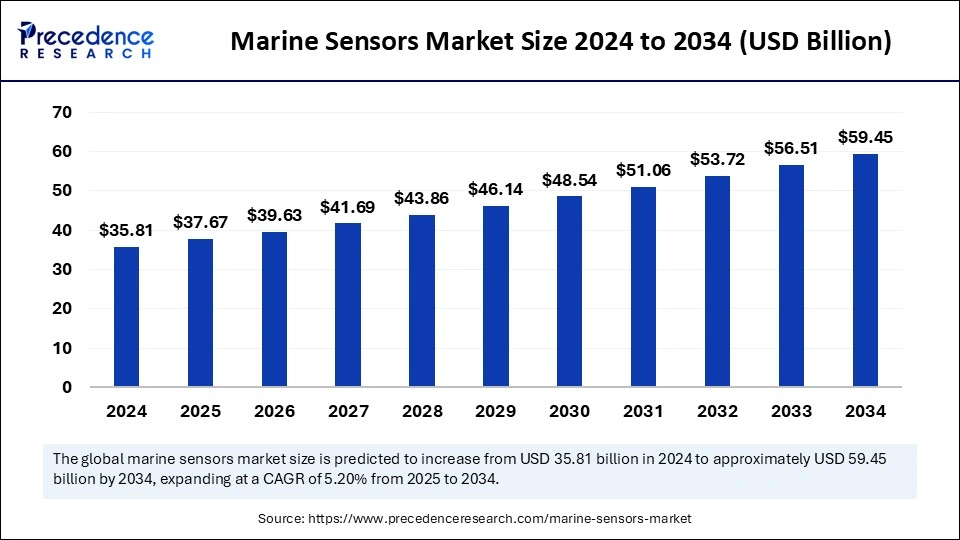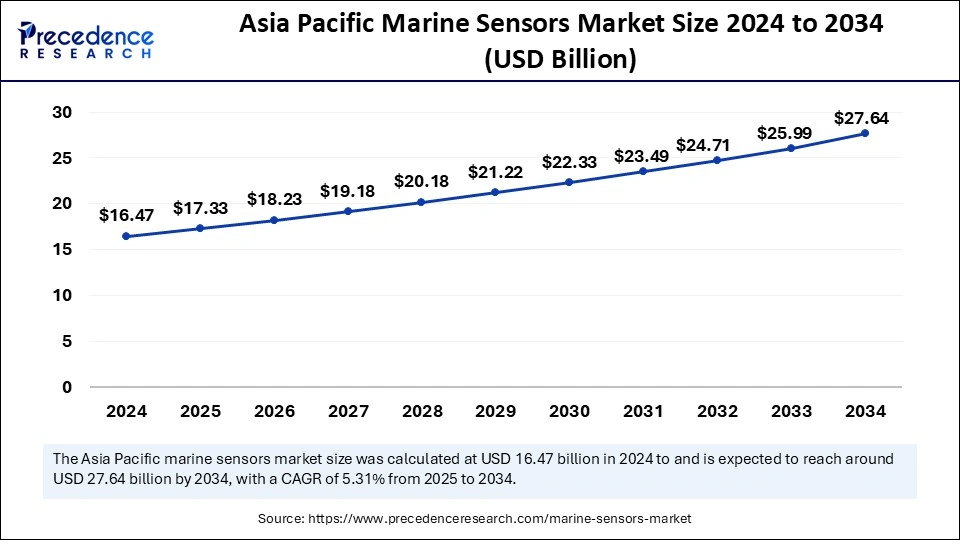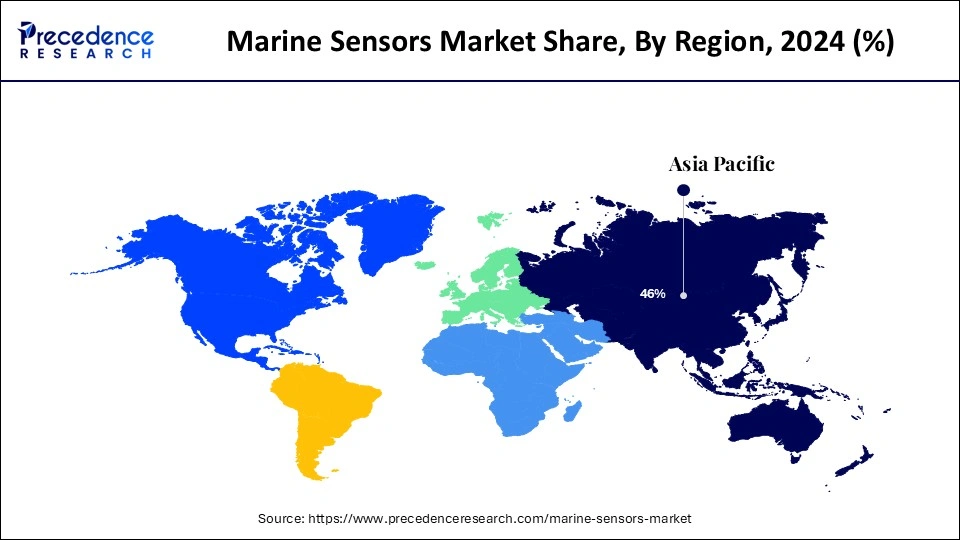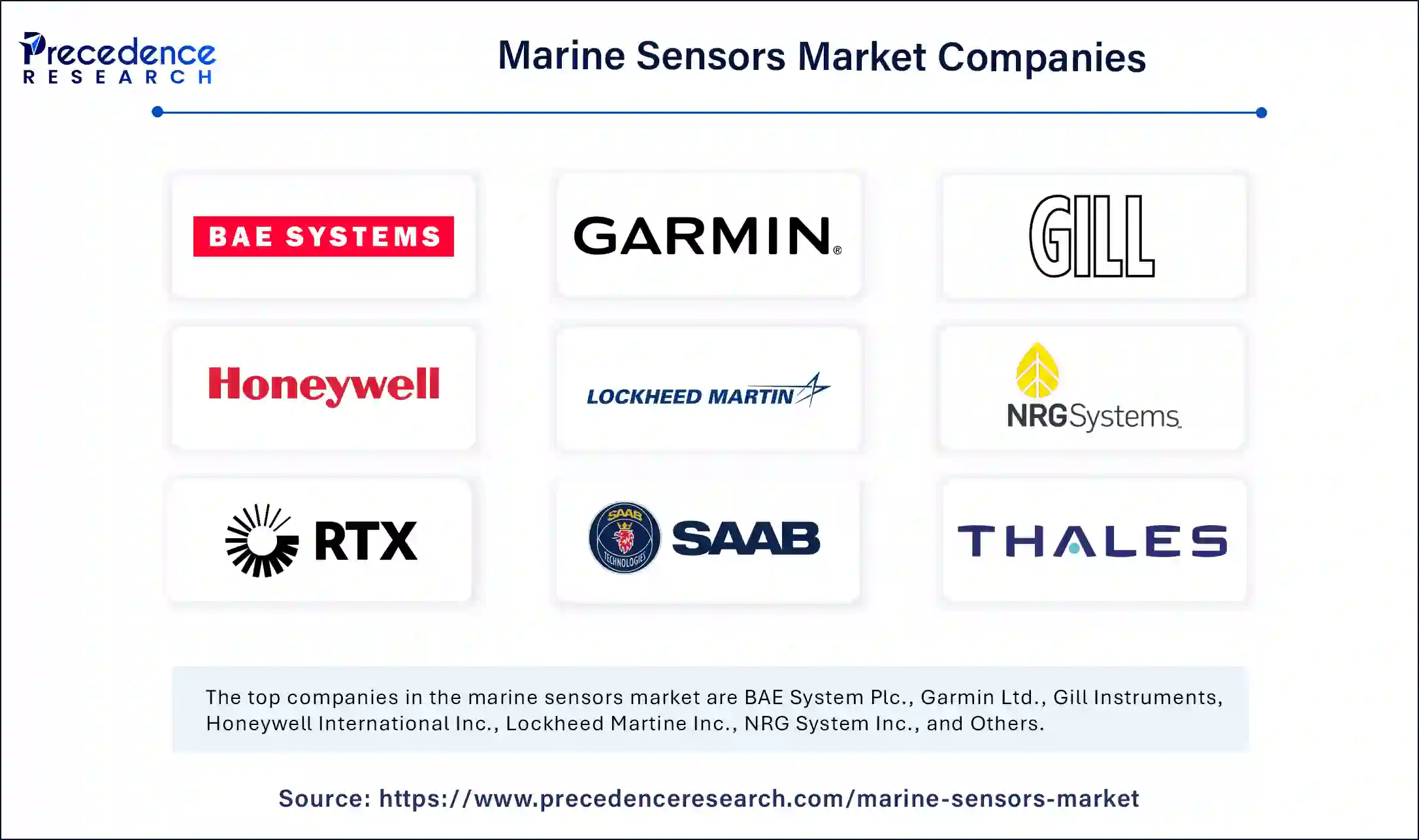August 2024
The global marine sensors market size is calculated at USD 37.67 billion in 2025 and is forecasted to reach around USD 59.45 billion by 2034, accelerating at a CAGR of 5.20% from 2025 to 2034. The Asia Pacific market size surpassed USD 16.47 billion in 2024 and is expanding at a CAGR of 5.31% during the forecast period. The market sizing and forecasts are revenue-based (USD Million/Billion), with 2024 as the base year.
The global marine sensors market size accounted for USD 35.81 billion in 2024 and is predicted to increase from USD 37.67 billion in 2025 to approximately USD 59.45 billion by 2034, expanding at a CAGR of 5.20% from 2025 to 2034. The global market growth is attributed to the increasing demand for AUV and ROV and the growing need for ocean monitoring.

The integration of Artifical Intelligence is set to significantly reshape the market in the coming years. Through analyzing data collected from marine sensors, AI can uncover trends and patterns that would be challenging or impossible to interpret manually. This valuable information can enhance marine efficiency, safety, and environmental protection. Furthermore, AI can analyze data from marine sensors to predict when maintenance is required, thereby helping to lower costs and minimize downtime. By monitoring real-time data from marine sensors, AI can identify potential issues, aiding in the prevention of environmental damage and accidents. Additionally, AI contributes to the reduction of fuel emissions and consumption.
The Asia Pacific marine sensors market size was exhibited at USD 16.47 billion in 2024 and is projected to be worth around USD 27.64 billion by 2034, growing at a CAGR of 5.31% from 2025 to 2034.

Asia Pacific dominated the marine sensors market in 2024. The market’s dominance in the region is driven by the expanding maritime trade and increasing robust economic growth. In addition, the growing commercial shipping activities and increasing burden of shipbuilding industry. The increasing focus on enhancing environmental regulations and maritime safety are a few factors that promoted the dominance of the region.
The market growth in India, South Korea, Singapore and China is attributed to the rising technological acceptance and invention of marine sensors across the globe. These countries had fast industrialization, urbanization, and middle-class populations are further expected to increase the demand for the maritime sensors market.

North America is seen to grow at the fastest pace in the marine sensors market during the forecast period. The market growth in the region is attributed to the increasing federal funding for military procurement plans for all military platforms, including the sea. In addition, an increasingly strong focus on environmental monitoring and marine research, increased deployment of underwater acoustic, and growing emphasis on maritime surveillance are further expected to drive the growth of the marine sensors market in the region. Furthermore, the U.S. and Canada are dominant countries that are seen to drive the market growth during the forecast period.
The market growth in the U.S. is attributed to the increasing focus on technological superiority, which continuously pushes the adoption and innovation of advanced marine sensor solutions. The U.S. is a major player in the market, driven by the increasing high demand across sectors such as environmental monitoring, shipping, defense, and oil and gas exploration, which further drive the market growth in the U.S.
Europe is observed to grow at a considerable growth rate in the upcoming period. The market growth in the region is attributed to the increasing demand for advanced sensor applications across the region and the increasing adoption of unmanned underwater vehicles and vessels for surveillance, naval threat protection, and other applications.
The marine sensors market deals with small devices used in various ship types for real-time data collection and environmental monitoring. These devices come in a wide range of forms with various uses. Marine sensors are used for inclination, acceleration, flow rates, temperature, pressure, and other uses. In addition, marine sensors play an important role in evaluating the marine vessel’s reliability and improving a ship’s performance. Furthermore, marine sensors help improve the performance capabilities of naval vessels, ships, and other boats and analyze components’ real-time data concerning their applications.
The marine sensors market is driven due to factors such as the rising integration of anti-jamming capabilities in naval vessels, increasing demand for advanced sensors for various applications, and the increasing need for ocean monitoring due to environmental changes. In addition, strict environmental and safety regulations call for an increasing demand for real-time data analytics are further expected to drive the growth of the market.
| Report Coverage | Details |
| Market Size by 2034 | USD 59.45 Billion |
| Market Size in 2025 | USD 37.67 Billion |
| Market Size in 2024 | USD 35.81 Billion |
| Market Growth Rate from 2025 to 2034 | CAGR of 5.20% |
| Dominated Region | Asia Pacific |
| Fastest Growing Market | North America |
| Base Year | 2024 |
| Forecast Period | 2025 to 2034 |
| Segments Covered | Type, Platform, Application, and Regions. |
| Regions Covered | North America, Europe, Asia-Pacific, Latin America and Middle East & Africa |
Fisheries and aquaculture sensors
Operations related to fishing and aquaculture significantly rely on the environment. Real-time data on characteristics such as water quality, oxygen content, salinity, and temperature can be obtained from sensors. The aquaculture environment can be precisely controlled and monitored with the use of this data, resulting in ideal circumstances for fish well-being and growth. Fisheries management authorities rely heavily on sensors to collect essential data and monitor fish populations for sustainable resource management. Acoustic sensors and underwater cameras are employed for non-invasive fish stock evaluations.
Sensor Interference
Inaccurate sensor readings can be fatal in industries such as vehicle safety systems and healthcare. Procedures or systems that depend on sensors can face interference that results in expensive downtime and impairs normal operation, decreased efficiency, and production delays. Sensor interference can also create major challenges and safety-critical activities in industries such as automotive and aviation, putting lives at risk and raising the likelihood of accidents. In addition, regular interference-related problems require troubleshooting and maintenance, which lowers system reliability and raises operating costs in the marine sensors market.
Remote sensing technologies
Ecosystems, wildlife habitats, and natural resource management are continuously monitored with the help of remote sensing. Early identification of environmental changes enables conservationists and authorities to make well-informed judgments about habitat preservation and resource management. Farmers can access data on water management, soil conditions, and crop health through remote sensing.
Precision farming is made possible by this data, which reduces environmental impact, boosts agricultural yields, and maximizes resource utilization. Data from remote sensing is useful for tracking urban expansion in urban regions, mapping land uses, and planning infrastructure. Remote sensing is a tool used by forestry experts to manage their timber resources, evaluate the health of forests, and monitor deforestation.
The flow and level sensors segment dominated the marine sensors market in 2024. These flow and level sensors are commonly used in marine fleets. To provide exceptional ship efficiency, the key players have been undertaking extensive research and developing integrated navigational sensors with enhancing capabilities. In addition, flow and level sensors are devices used for measuring the quantity or flow rate of a moving gas or liquid, which improves their performance. In addition, there are many types of ballast water management systems for incoming system pressure, tank level, and water flow. These instruments are stable, reliable, and essential for key specifications. It optimizes energy consumption, provides a data decision-making basis for the cooling control system, and monitors the flow of seawater pipelines.
The acoustic sensors segment is expected to grow fastest during the forecast period. The segment growth in the market is attributed to the various advantages associated with acoustic sensors, such as improving safety, protecting marine life, and reducing noise pollution by providing real-time data on hazards and sound levels, which further propels the growth of the marine sensors market. Acoustic sensors play an important role, from maritime navigation to environmental monitoring, as they analyze and detect underwater sound waves. In addition, acoustic sensors are devices designed to analyze, measure, and detect sound waves in various mediums, such as solids, water, or air. These sensors allow for the detection and interpretation of acoustic signals and convert sound waves into electrical signals.
The military defense segment dominated the marine sensors market in 2024. The market growth in the market is attributed to the increasing use of technology-based sensors in military ships, vessels, submarines, and others to protect and give them real-time situational awareness. Military and defense applications often need a multi-layered solution that uses the latest hardware sensors such as PIDS, RF signal triangulation, radar, infrared, and visible imaging for awareness and threat detection that can be improved for air and marine.
The commercial segment is expected to grow fastest during the forecast period. The segment growth in the marine sensors market is driven by the increasing utilization of commercial ships and marine transportation. Marine sensors are used for inclination, acceleration, flow rates, temperature, pressure, and other purposes. In addition, commercial sensors play an important role in evaluating the marine vessel's reliability and improving a ship's performance.
The surveillance and monitoring segment dominated the marine sensors market in 2024. The segment growth in the market is attributed to the increasing developments in reconnaissance and intelligence sensors assisting in analyzing information about the potential location, enemy, and others. Maritime sensors can pinpoint undersea objects with artificial intelligence technology and make autonomous vessels more reliable. In addition, monitoring and surveillance sensors enable intelligence and military organizations to detect real-time data.
The communication and navigation segment is expected to grow fastest during the forecast period. The segment growth in the marine sensors market is driven by rising technological advancements in semiconductors, specific to indium phosphide and gallium arsenide. The usage of wide bandwidth also enables the targeting of various objects. Marine sensors play an important role in targeting applications to detect underwater objects and surfaces.

By Type
By Platform
By Application
By Region
For inquiries regarding discounts, bulk purchases, or customization requests, please contact us at sales@precedenceresearch.com
No cookie-cutter, only authentic analysis – take the 1st step to become a Precedence Research client
August 2024
September 2024
March 2025
July 2024